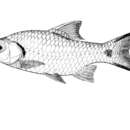Diagnostic Description
provided by Fishbase
With 4 barbels (Ref. 43281); anterior maxillary ("rostral") barbels present (Ref. 12693); last simple dorsal ray osseous and serrated posteriorly; conspicuous black blotch on caudal peduncle; small, vertically elongated, black spot below dorsal origin; narrow dark band from upper extremity of gill opening to pectoral base; caudal fin orange red with a conspicuous broad black marginal stripe on each lobe; usually longitudinal rows of black spots along scale rows (Ref. 43281).
Morphology
provided by Fishbase
Dorsal spines (total): 4; Dorsal soft rays (total): 8; Analspines: 2; Analsoft rays: 5
Trophic Strategy
provided by Fishbase
Effects annual upstream non-reproductive and downstream reproductive migrations.
Biology
provided by Fishbase
Occurs in rivers of all sizes, but mainly in smaller streams, canals and on floodplains. Occasionally found in impoundments, but usually stays in the flowing streams leading to the impoundment. Moves into seasonally inundated areas and breeds at the start of the rainy season. Young of the year appear in streams in July and August. Adults leave the floodplains when the water recedes in December or January (Ref. 12693). Captured from the wild for the ornamental fish trade in Thailand (Ref. 6459). Marketed fresh or made into prahoc along the Tonle Sap (Ref. 12693).
Importance
provided by Fishbase
fisheries: minor commercial

